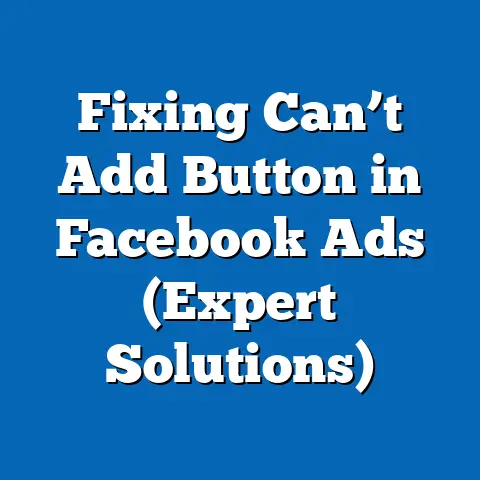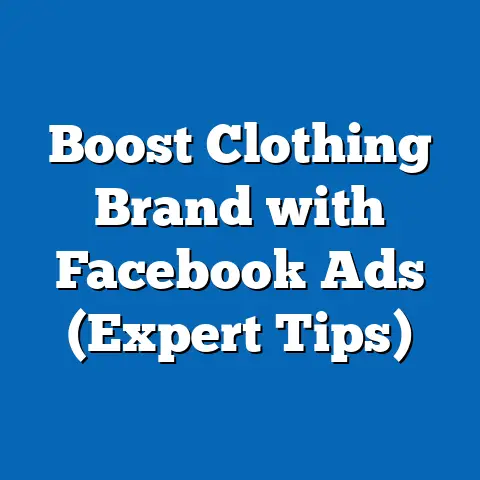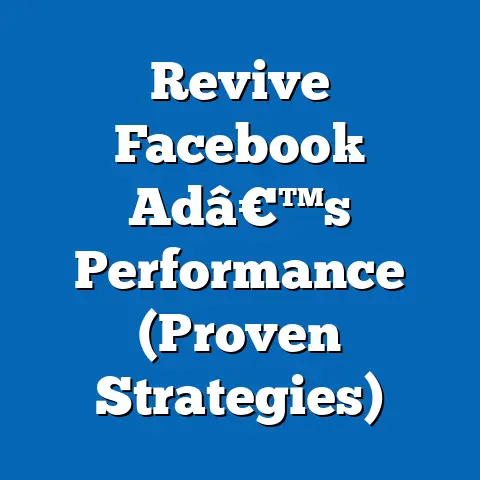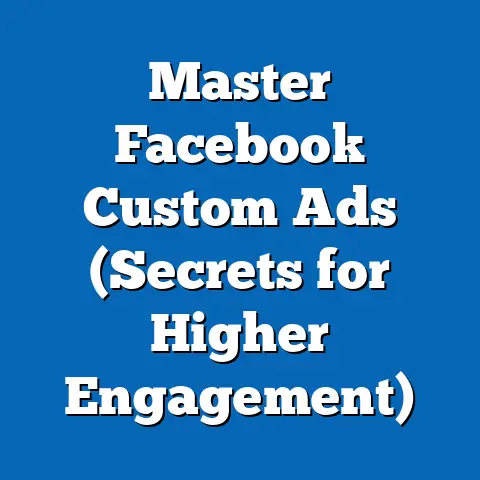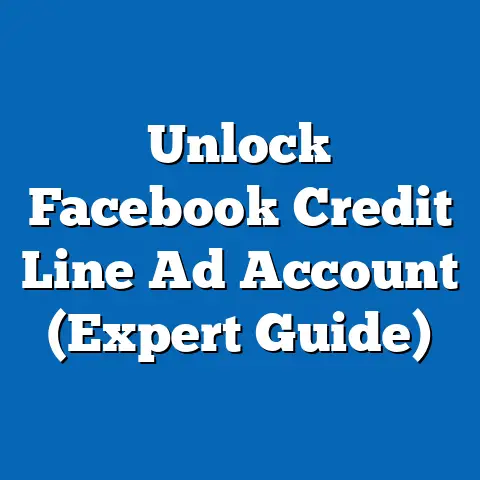Launch Affiliate Marketing with Facebook Ads (Pro Tips)
Imagine you’re planting a garden. You wouldn’t just toss seeds haphazardly onto the ground and hope for the best, would you? You’d carefully select your seeds, prepare the soil, provide water and sunlight, and diligently weed out anything that might hinder growth. Launching an affiliate marketing business with Facebook ads is very similar. It requires careful planning, strategic execution, and consistent nurturing to blossom into a profitable venture.
I’ve seen countless affiliate marketers struggle, not because they lack the ambition, but because they lack a solid understanding of the fundamentals and advanced strategies needed to thrive on Facebook. They treat their campaigns like those haphazardly tossed seeds, and unsurprisingly, the results are often disappointing.
Section 1: Understanding Affiliate Marketing
At its core, affiliate marketing is a performance-based marketing strategy where you, as an affiliate, earn a commission for promoting another person’s or company’s products or services. You essentially act as a bridge between the merchant and the consumer, and you get rewarded for every sale you generate.
Think of it like this: you recommend a fantastic new coffee machine to your friends on Facebook. If they click your unique affiliate link and purchase the machine, you earn a commission from the manufacturer. It’s a win-win situation: the merchant gains a new customer, the customer discovers a great product, and you get rewarded for your efforts.
The Key Players:
- The Affiliate (You): The marketer who promotes the product or service.
- The Merchant: The business that owns the product or service.
- The Consumer: The end customer who purchases the product or service.
Why is Affiliate Marketing So Popular?
- Low Barrier to Entry: You don’t need to create your own products or services.
- Flexibility: You can work from anywhere with an internet connection.
- Scalability: You can promote multiple products and scale your income potential.
- Performance-Based: You only get paid when you generate results.
The affiliate marketing industry is booming. According to Statista, global affiliate marketing spending is projected to reach \$15.7 billion in 2024. This massive growth highlights the immense potential for affiliate marketers to generate significant income by strategically leveraging platforms like Facebook.
Takeaway: Affiliate marketing is a powerful way to earn income by promoting other people’s products. Understanding the roles and the benefits is the first step to building a successful business.
Section 2: The Role of Facebook Ads in Affiliate Marketing
While there are many ways to promote affiliate products (blogging, email marketing, organic social media), Facebook ads offer a unique combination of reach, targeting, and cost-effectiveness that makes them a particularly powerful tool for affiliate marketers.
I remember when I first started with affiliate marketing, I relied solely on organic traffic. It was slow, unpredictable, and frankly, frustrating. Once I started experimenting with Facebook ads, everything changed. I could reach a much wider audience, target specific demographics and interests, and quickly test different ad creatives and offers.
Why Facebook Ads are a Game-Changer:
- Massive Reach: Facebook boasts billions of active users, providing access to a vast potential customer base.
- Granular Targeting: Facebook’s sophisticated targeting options allow you to reach specific demographics, interests, behaviors, and even custom audiences based on your existing customer data. This means you can show your ads to the people who are most likely to be interested in your affiliate product.
- Cost-Effectiveness: While ad costs can vary, Facebook ads can be incredibly cost-effective when done right. You have complete control over your budget and can adjust your campaigns based on performance to maximize your ROI.
- Measurable Results: Facebook Ads Manager provides detailed analytics that allow you to track your campaign performance, identify what’s working, and optimize your ads for better results.
- Diverse Ad Formats: Facebook offers a variety of ad formats to choose from, allowing you to create engaging and visually appealing ads that capture attention and drive conversions.
Types of Facebook Ads for Affiliate Marketers:
- Image Ads: Simple and effective for showcasing a product or service.
- Video Ads: Highly engaging for capturing attention and telling a story.
- Carousel Ads: Allow you to showcase multiple products or features in a single ad.
- Collection Ads: Ideal for e-commerce, allowing users to browse and purchase products directly from the ad.
- Lead Ads: Collect leads directly from Facebook without sending users to a landing page.
Takeaway: Facebook ads provide unparalleled reach, targeting, and measurability, making them an essential tool for any affiliate marketer looking to scale their business.
Section 3: Setting Up for Success
Before diving into the technical aspects of creating Facebook ads, it’s crucial to lay a solid foundation for your affiliate marketing venture. This involves selecting a profitable niche and choosing the right affiliate programs.
1. Choosing Your Niche:
Your niche is the specific segment of the market you’ll be focusing on. It could be anything from fitness and nutrition to home decor and gardening. The key is to choose a niche that aligns with your interests, has strong market demand, and offers profitable affiliate programs.
Here’s my advice:
- Passion is Key: Choose a niche that you’re genuinely interested in. This will make the process more enjoyable and sustainable.
- Market Research is Essential: Use tools like Google Trends, SEMrush, and Ahrefs to research the demand for your chosen niche and identify potential keywords.
- Profitability Matters: Research the affiliate programs available in your niche and analyze their commission rates and conversion rates.
2. Selecting the Right Affiliate Programs:
Once you’ve chosen your niche, it’s time to find affiliate programs that offer relevant products or services. There are several factors to consider when evaluating affiliate programs:
- Commission Rates: What percentage of the sale will you earn?
- Conversion Rates: How well does the product or service convert leads into sales?
- Reputation: Is the merchant reputable and reliable?
- Payment Terms: How often will you get paid, and what are the payment methods?
- Support: Does the program offer adequate support and resources?
Where to Find Affiliate Programs:
- Affiliate Networks: Platforms like Commission Junction (CJ Affiliate), ShareASale, and Awin connect affiliates with merchants.
- Direct Programs: Many companies offer their own affiliate programs directly.
- Amazon Associates: A popular option for promoting products on Amazon.
Takeaway: Choosing the right niche and affiliate programs is crucial for building a successful affiliate marketing business. Do your research, align your interests with market demand, and prioritize profitability.
Section 4: Crafting Compelling Facebook Ads
Now for the fun part: creating Facebook ads that grab attention, generate clicks, and drive conversions! This is where your creativity and marketing skills come into play.
My Step-by-Step Guide to Creating Effective Ad Content:
-
Attention-Grabbing Headlines:
- Your headline is the first thing people see, so make it count. Use strong keywords, create a sense of urgency, or ask a compelling question.
- Example: “Finally! A Natural Solution for [Problem] That Actually Works!” or “Are You Tired of [Pain Point]? Discover the Secret to [Desired Outcome]!”
-
Visually Appealing Images or Videos:
-
Use high-quality images or videos that showcase the product or service in an appealing way.
- Consider using lifestyle images that show people using the product in real-life situations.
- Video ads are particularly effective for capturing attention and telling a story.
-
Persuasive Ad Copy:
-
Highlight the benefits of the product or service and explain how it solves a problem or fulfills a need.
- Use persuasive language, social proof (testimonials, reviews), and a clear call to action.
- Keep your ad copy concise and easy to read.
-
Clear Call to Action (CTA):
-
Tell people exactly what you want them to do. Use strong action verbs like “Shop Now,” “Learn More,” “Get Started,” or “Download Now.”
- Make your CTA button visually prominent and easy to click.
Attention-Grabbing Headlines:
- Your headline is the first thing people see, so make it count. Use strong keywords, create a sense of urgency, or ask a compelling question.
- Example: “Finally! A Natural Solution for [Problem] That Actually Works!” or “Are You Tired of [Pain Point]? Discover the Secret to [Desired Outcome]!”
-
Visually Appealing Images or Videos:
-
Use high-quality images or videos that showcase the product or service in an appealing way.
- Consider using lifestyle images that show people using the product in real-life situations.
- Video ads are particularly effective for capturing attention and telling a story.
-
Persuasive Ad Copy:
-
Highlight the benefits of the product or service and explain how it solves a problem or fulfills a need.
- Use persuasive language, social proof (testimonials, reviews), and a clear call to action.
- Keep your ad copy concise and easy to read.
-
Clear Call to Action (CTA):
-
Tell people exactly what you want them to do. Use strong action verbs like “Shop Now,” “Learn More,” “Get Started,” or “Download Now.”
- Make your CTA button visually prominent and easy to click.
Visually Appealing Images or Videos:
Use high-quality images or videos that showcase the product or service in an appealing way.
Persuasive Ad Copy:
Highlight the benefits of the product or service and explain how it solves a problem or fulfills a need.
Clear Call to Action (CTA):
Tell people exactly what you want them to do. Use strong action verbs like “Shop Now,” “Learn More,” “Get Started,” or “Download Now.”
Pro Tips for Writing Persuasive Ad Copy:
- Focus on Benefits, Not Features: Explain how the product will improve the customer’s life.
- Use Storytelling: Tell a compelling story that resonates with your target audience.
- Create a Sense of Urgency: Use phrases like “Limited Time Offer” or “While Supplies Last.”
- Address Objections: Anticipate and address potential objections that customers might have.
- Use Power Words: Words like “Free,” “New,” “Secret,” and “Guaranteed” can be highly effective.
Takeaway: Crafting compelling Facebook ads requires a combination of creativity, persuasive writing, and a deep understanding of your target audience. Focus on grabbing attention, highlighting benefits, and using a clear call to action.
Section 5: Targeting the Right Audience
Even the most compelling ad will fall flat if it’s shown to the wrong people. That’s why Facebook’s audience targeting options are so crucial for affiliate marketing success.
Understanding Facebook’s Audience Targeting Options:
- Demographics: Target people based on age, gender, education, location, relationship status, and more.
- Interests: Target people based on their interests, hobbies, and activities.
- Behaviors: Target people based on their online behavior, purchase history, and device usage.
- Custom Audiences: Create custom audiences based on your existing customer data, such as email lists or website visitors.
- Lookalike Audiences: Create lookalike audiences based on your custom audiences. This allows you to reach new people who are similar to your existing customers.
How to Use Facebook’s Targeting Options Effectively:
-
Start with a Broad Audience:
- If you’re unsure who your target audience is, start with a broad audience based on demographics and interests.
-
Refine Your Audience:
-
As you gather data, refine your audience based on performance. Exclude demographics or interests that aren’t performing well.
-
Use Custom Audiences:
-
Upload your email list or create a custom audience based on website visitors.
-
Create Lookalike Audiences:
-
Use your custom audiences to create lookalike audiences. This can be a highly effective way to reach new customers.
-
Segment Your Audience:
-
Create different ad sets for different audience segments. This allows you to tailor your ads to each segment.
Start with a Broad Audience:
- If you’re unsure who your target audience is, start with a broad audience based on demographics and interests.
-
Refine Your Audience:
-
As you gather data, refine your audience based on performance. Exclude demographics or interests that aren’t performing well.
-
Use Custom Audiences:
-
Upload your email list or create a custom audience based on website visitors.
-
Create Lookalike Audiences:
-
Use your custom audiences to create lookalike audiences. This can be a highly effective way to reach new customers.
-
Segment Your Audience:
-
Create different ad sets for different audience segments. This allows you to tailor your ads to each segment.
Refine Your Audience:
As you gather data, refine your audience based on performance. Exclude demographics or interests that aren’t performing well.
Use Custom Audiences:
Upload your email list or create a custom audience based on website visitors.
Create Lookalike Audiences:
Use your custom audiences to create lookalike audiences. This can be a highly effective way to reach new customers.
Segment Your Audience:
Create different ad sets for different audience segments. This allows you to tailor your ads to each segment.
Example:
Let’s say you’re promoting a weight loss supplement. You could target:
- Demographics: Women aged 25-55.
- Interests: Weight loss, fitness, healthy eating.
- Behaviors: People who have purchased weight loss products online.
- Custom Audience: People who have visited your website or signed up for your email list.
- Lookalike Audience: People who are similar to your existing customers.
Takeaway: Facebook’s audience targeting options are incredibly powerful. Use them strategically to reach the people who are most likely to be interested in your affiliate product and maximize your ROI.
Section 6: Budgeting and Bidding Strategies
Setting the right budget and choosing the right bidding strategy are crucial for controlling your costs and maximizing your profits.
Setting Your Advertising Budget:
- Start Small: Begin with a small daily budget and gradually increase it as you see results.
- Consider Your Commission Rate: Calculate how many sales you need to generate to break even and make a profit.
- Test Different Budgets: Experiment with different budgets to see what works best for your campaigns.
- Track Your ROI: Monitor your return on investment (ROI) closely and adjust your budget accordingly.
Bidding Strategies:
Facebook offers several bidding strategies to choose from:
- Lowest Cost: Facebook will try to get you the most results for your budget.
- Cost Per Result Goal: You set a target cost per result, and Facebook will try to achieve that goal.
- Manual Bidding: You set your own bids for each ad auction.
When to Use Each Bidding Strategy:
- Lowest Cost: Ideal for beginners who want to let Facebook optimize their bids.
- Cost Per Result Goal: Useful for experienced advertisers who have a clear understanding of their target cost per result.
- Manual Bidding: Suitable for advanced advertisers who want complete control over their bids.
My Recommendation:
I typically recommend starting with the “Lowest Cost” bidding strategy and then experimenting with “Cost Per Result Goal” once you have enough data. Manual bidding can be effective, but it requires a deep understanding of Facebook’s ad auction.
Takeaway: Setting the right budget and choosing the right bidding strategy are crucial for controlling your costs and maximizing your profits. Start small, test different options, and track your ROI closely.
Section 7: Analyzing and Optimizing Campaigns
The key to long-term success with Facebook ads is continuous analysis and optimization. You need to track your campaign performance, identify what’s working, and make adjustments to improve your results.
Key Performance Indicators (KPIs) for Affiliate Marketing:
- Click-Through Rate (CTR): The percentage of people who click on your ad after seeing it.
- Conversion Rate: The percentage of people who purchase your affiliate product after clicking on your ad.
- Cost Per Click (CPC): The amount you pay each time someone clicks on your ad.
- Cost Per Conversion (CPC): The amount you pay for each sale you generate.
- Return on Ad Spend (ROAS): The amount of revenue you generate for every dollar you spend on advertising.
How to Track Your Campaign Performance:
- Facebook Ads Manager: Use Facebook Ads Manager to track your campaign performance in real-time.
- Affiliate Program Dashboard: Monitor your sales and commissions in your affiliate program dashboard.
- Google Analytics: Use Google Analytics to track website traffic and conversions.
Strategies for A/B Testing:
A/B testing is a powerful way to improve your ad effectiveness. Test different headlines, images, ad copy, and targeting options to see what works best.
- Test One Variable at a Time: Only change one variable at a time so you can accurately measure the impact of each change.
- Use a Control Group: Compare your test ad to a control ad that remains unchanged.
- Track Your Results: Monitor your results closely and make adjustments based on the data.
Tips for Adjusting Campaigns Based on Performance Data:
- Pause Underperforming Ads: If an ad is not performing well, pause it.
- Increase Budget for High-Performing Ads: If an ad is performing well, increase the budget to reach more people.
- Refine Your Targeting: Based on your data, refine your targeting to reach the people who are most likely to convert.
- Experiment with New Creatives: Continuously experiment with new headlines, images, and ad copy to keep your ads fresh and engaging.
Takeaway: Continuous analysis and optimization are crucial for long-term success with Facebook ads. Track your KPIs, A/B test different options, and make adjustments based on the data.
Section 8: Compliance and Best Practices
It’s crucial to adhere to Facebook’s advertising policies and ethical considerations to maintain a positive reputation and avoid getting your account banned.
Facebook Advertising Policies:
Facebook has strict advertising policies that you must adhere to. These policies cover a wide range of topics, including:
- Prohibited Content: Facebook prohibits ads that promote illegal products or services, discrimination, hate speech, or violence.
- Misleading or Deceptive Practices: Facebook prohibits ads that are misleading, deceptive, or unrealistic.
- Personal Attributes: Facebook prohibits ads that discriminate against people based on personal attributes like race, ethnicity, religion, gender, or sexual orientation.
- Health and Medical Content: Facebook has strict rules about advertising health and medical products or services.
Ethical Considerations of Affiliate Marketing:
- Transparency: Be transparent about the fact that you are an affiliate and that you earn a commission for promoting the product.
- Disclosure: Disclose your affiliate relationship in your ads and on your website.
- Honesty: Be honest about the product or service you are promoting. Don’t make false or misleading claims.
- Relevance: Promote products or services that are relevant to your audience and that you genuinely believe in.
Best Practices for Maintaining a Positive Reputation:
- Provide Value: Focus on providing value to your audience. Don’t just promote products; offer helpful information and resources.
- Build Relationships: Build relationships with your audience. Engage with them on social media and respond to their questions and comments.
- Be Responsive: Respond to customer inquiries promptly and professionally.
- Monitor Your Reputation: Monitor your online reputation and address any negative reviews or comments.
Takeaway: Adhering to Facebook’s advertising policies and ethical considerations is crucial for maintaining a positive reputation and avoiding getting your account banned. Be transparent, honest, and focused on providing value to your audience.
Section 9: Scaling Your Affiliate Marketing Efforts
Once you’ve established a successful Facebook ad campaign, you can start scaling your efforts to reach a wider audience and generate more revenue.
Strategies for Scaling Successful Facebook Ad Campaigns:
- Increase Your Budget: Gradually increase your budget to reach more people.
- Expand Your Targeting: Expand your targeting to reach new demographics, interests, or behaviors.
- Leverage Lookalike Audiences: Use your custom audiences to create lookalike audiences and reach new people who are similar to your existing customers.
- Retargeting: Retarget people who have visited your website or engaged with your ads but haven’t yet converted.
- Diversify Your Traffic Sources: Don’t rely solely on Facebook ads. Explore other traffic sources like Google Ads, email marketing, or organic social media.
The Power of Retargeting:
Retargeting is a highly effective way to scale your campaigns. It allows you to show ads to people who have already expressed interest in your product or service.
- Website Visitors: Retarget people who have visited your website but haven’t made a purchase.
- Ad Engagers: Retarget people who have engaged with your ads but haven’t clicked through to your website.
- Video Viewers: Retarget people who have watched a certain percentage of your video ads.
Diversifying Your Traffic Sources:
While Facebook ads can be a powerful tool, it’s important to diversify your traffic sources to reduce your reliance on a single platform.
- Google Ads: Use Google Ads to reach people who are searching for your product or service on Google.
- Email Marketing: Build an email list and promote your affiliate products to your subscribers.
- Organic Social Media: Use organic social media to build a following and promote your affiliate products.
Takeaway: Scaling your affiliate marketing efforts requires a strategic approach. Increase your budget, expand your targeting, leverage lookalike audiences and retargeting, and diversify your traffic sources.
Conclusion
Just like a gardener nurtures their plants, adapts to changing seasons, and continuously refines their techniques, successful affiliate marketers must constantly learn, adapt, and optimize their strategies. The world of Facebook advertising is ever-evolving, so staying informed about the latest trends and best practices is crucial.
Now, go forth and plant your affiliate marketing garden!
Call to Action
I’d love to hear about your experiences with affiliate marketing and Facebook ads. Share your tips, challenges, and successes in the comments below or on social media using the hashtag #FacebookAdsAffiliate.
For more insights and updates on affiliate marketing strategies, subscribe to my newsletter and follow me on social media. Let’s grow together!

